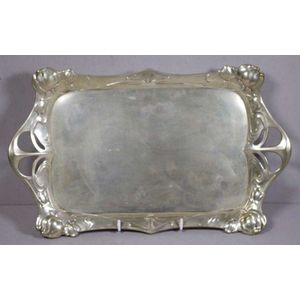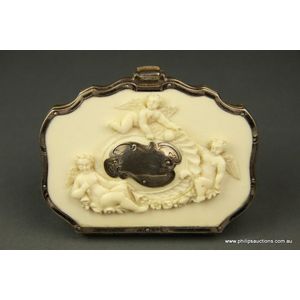Ivory and Silver Communion Purse, Late 19th Century
You must be a subscriber, and be logged in to view price and dealer details.
Subscribe Now to view actual auction price for this item
When you subscribe, you have the option of setting the currency in which to display prices to $Au, $US, $NZ or Stg.
- Floral Swag / Garland / Festoon - Floral swags are a decorative motif often used in the ornamentation of various objects, such as silverware, glassware, and furniture. The term "swag" refers to a garland or wreath of flowers, foliage, or other decorative elements, which is usually arranged in a loop or curve.
Floral swags can be found in a variety of decorative styles, from ornate Baroque and Rococo designs to more naturalistic Art Nouveau and Art Deco styles. They are often used to add a touch of elegance, refinement, or whimsy to an object, and can be seen on a range of items from chandeliers and candlesticks to picture frames and tea sets.
In the decoration of silver objects, floral swags are often used to accentuate the curves and lines of the piece, and to add visual interest to the surface. Similarly, on glass objects, floral swags may be used to frame or highlight a particular area of the object, or to add a touch of color and delicacy.
On furniture, floral swags can be found on a variety of pieces, from cabinets and armoires to chairs and sofas. They are often used to enhance the lines and curves of the furniture, and can be used to create a sense of movement and flow in the design.
Overall, floral swags are a versatile decorative element that can be adapted to a range of styles and applications, and have been used in the decoration of various objects throughout history. - Putto / Putti / Amorino / Amorini - A putto (plural: putti) or amerino (plural: amerini) is a cherub or cupid frequently appearing in both mythological and religious paintings and sculpture, especially of the Renaissance and Baroque periods and later used as a decorative element in the design of furniture, ceramics, statuary etc. They are usually depicted as chubby males, or of indeterminate gender, often with wings. Their depiction may represent an association with love, heaven, peace or prosperity.
- Cartouche - An ornamental panel in the form of of a shield, oval or rectangular scroll with curling edges. It may be carved into the back of a chair or the top of a sideboard, or present on a piece of silver or jewellery, and contain the initials of the original owner, heraldic symbols, or some other inscription, such as the details of a presentation.
In ceramics the term defines the central area of a vase or similar with a decorative border in one of the shapes above, into which a decorative scene or figures have been painted. - Ivory - Ivory is a hard white material that comes from the tusks of elephants, mammoth, walrus and boar, or from the teeth of hippopotamus and whales. The ivory from the African elephant is the most prized source of ivory. Although the mammoth is extinct, tusks are still being unearthed in Russia and offered for sale.
Ivory has been used since the earliest times as a material for sculpture of small items, both in Europe and the east, principally China and Japan.
In Asia ivory has been carved for netsuke, seals, okimono, card cases, fan supports, animals and other figures and even as carved tusks.
In the last 200 years in Europe ivory has been used to carve figures, for elaborate tankards, snuff boxes, cane handles, embroidery and sewing accessories, in jewellery and as inlay on furniture. Its more practical uses include being used for billiard balls, buttons, and a veneers on the top of piano keys.
The use and trade of elephant ivory have become controversial because they have contributed to Due to the decline in elephant populations because of the trade in ivory, the Asian elephant was placed on Appendix One of the Convention on International Trade in Endangered Species (CITES), in 1975, and in January 1990, the African elephant was similarly listed. Under Appendix One, international trade in Asian or African elephant ivory between member countries is forbidden. Unlike trade in elephant tusks, trade in mammoth tusks is legal.
Since the invention of plastics, there have been many attempts to create an artificial ivory
This item has been included into following indexes:
- religious objects, Christian
Visually similar items

A Victorian silver 'castletop' silver card case, Nathaniel Mills, Birmingham 1847 depicting Buckingham House London, after the additions made by George IV, with Marble Arch in the foreground, height 10 cm, weight 2.5oz, weight 72gms

WMF Art Nouveau Jugendstil silver plated Tray, circa 1910, 40.8 cm x 24.8 cm

Large Victorian sterling silver double handled banquet tray of quatrefoil outline with wide rococo and acanthus cast rim, the centre engraved all over with Celtic designs, 80 cm width, London 1840

Pewter L'Iniment Geneau Paris Horse plate, approx 27 cm long, 20 cm wide
